Guest Editorial: The Animals Called Noah, Too
By Jay McDaniel
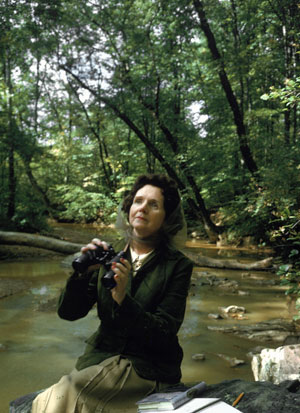
Noah returned to earth many years ago as Rachel Carson. Her book Silent Spring, published in 1962, invited people to recognize that springtime will indeed be silent unless we listen and respond to other animals with respect and care. Rachel Carson was a good scientist but also a good listener. She knew that music is not reducible to human sounds. Trained in marine biology, she could hear the songs of the whales. She wrote bestselling books about the wonders of marine life: The Edge of the Sea and The Sea Around Us. We know from Silent Spring that she could hear the melodies of the songbirds, too.
To Save, to Listen
Her kind of listening – call it the listening side of love – is part of science at its best. Science can be understood as one way that human beings try to listen to the world, with particular attention to its recurring patterns and rhythms. But this listening is sometimes neglected by muscular and zealous Christians and other persons of faith who want to go out and save the planet. There is something overdue, yet also something overhasty, about wanting to save the planet. The system of factory farming that causes so much pain and harm does indeed need to be dismantled. The habitats of wild animals do indeed need preserving not only for our sake but also for the animals’ sake. The waters need cleaning and the air needs purifying and freshening. We can appreciate it when we hear Christian and other spiritual activists say: “Let’s roll up our sleeves and get on with the task of saving the planet.”
But we must also be uneasy. There is something insufficiently receptive about this gregarious approach to life: something we might learn from Zen. The animals and plants do not simply want to be saved; they also want to be listened to and appreciated on their own terms and for their own sakes. Without listening, even the most prophetic of actions can become a will-to-mastery trapped by good intentions. Let’s imagine, then, that Rachel Carson has now returned to our planet as a local pastor who is preparing a sermon on the occasion of a Blessing for the Animals. What would she say? Here is one possibility:
In the beginning is not the word: it is the listening. Families cannot live happily as families, and friends as friends, unless they listen to one another. Neighbors cannot live peacefully as neighbors, and nations as nations, unless first they hear one another’s concerns. Farmers cannot till the soil, and poets cannot stir our minds, unless they listen to the sounds of creation: to the rhythms of the seasons, the songs of the birds, the howling of the wolves, the music of the spheres.
God Listens
Even God must begin with listening. God cannot respond to the cries of the world, or the laughter of children, or the songs of whales, unless God first listens. Otherwise how can God hear prayers? How can God know how to respond to what happens? Of course some people who believe in God will reject the notion of a listening God because they think that God does not need to listen. From their perspective God knows all things in advance, because the script of history is already written in God’s mind. Nothing can surprise God. To bolster their case that God is invulnerable, they may add that there was a time, some thirteen billion years ago, when there was nothing for God to listen to, because the universe did not yet exist.
But the creation story in Genesis suggests the contrary. This story suggests that during this time there was a watery chaos, a creative energy, from which God called the universe into existence. If this is the case, then God had to listen to the potentialities within the chaos in order to call the world into existence. Still more poignantly, God had to listen to a yearning within the divine heart: a yearning for the chaos to evolve into the heavens and the earth. What was this yearning? Did God seek companionship? We really do not know. What we do know is that from the very beginning, even in God, there had to be a listening.
Therefore I Listen
Let’s say that we are made in God’s image and that our calling in life is to live in a way that is inwardly inspired by God’s listening. The New Testament invites us to walk in love as Christ walked in love. Perhaps this is to walk in the listening. If this is true then there is something very radical about this idea. Our calling in life is not to be rich, powerful, and famous. It is not to make our mark in history or receive flattery. It is not even to claim our Christian or other religious identity, like a flag we want to want to wave in other people’s faces. Instead it is to accept the vulnerable, momentary nature of life and walk through life as best we can by dwelling lightly on the earth and gently with others, day by day and moment by moment. It is to live with integrity, not ambition.
This life of integrity requires creativity as well as listening. But the creativity must come from the listening, not in advance of it. We cannot approach the natural world with pre-designed game plans concerning how it can be managed. Instead we must listen to it, with a heart of wonder and humility, and then determine what is needed. Only if our creativity flows from our listening, will it be constructive rather than destructive, compassionate rather than violent, helpful rather than harmful. Listening and Creativity: these are the yin and yang of the callings we receive from God.
We Christians believe that Jesus was the listening incarnate. We see his healing ministry as a revelation of divine listening and his improvised responses a revelation of divine creativity. He was true to his callings, to the best of his abilities. Surely, if he was human, he fell short of his callings sometimes. He was like us in all respects, but more vulnerable and therefore more fully human. It is in his humanity that, for us, he is a window into a love supreme.
To Be Ordained
The callings need not come from outside us as a particularized voice from heaven. They come to us every time we encounter the face of another person, or another animal, or a landscape. In their very presence to us we experience a calling, an invitation, to pay attention and to care. Just as in some religious traditions, certain persons are ordained to the ministry or priesthood, we are all ordained by these calls. Not just by the humans. The animals ordain us, too. If we are priests it is from the animals that we receive our blessings.
-710281.jpg) This is how it worked with Noah. The story tells us that God commanded him to create an ark to protect the animals. But the animals called Noah, too. God’s call was first of all a call to listen to the animals, to hear their callings, and to be ordained by them. But how did God know to do this? Why did God even care? The calling originated out of God’s own listening: a listening to their sufferings and their joys, their playfulness and their wisdom. Listening changes the listener. It is from this listening that God decided to establish a covenant with the animals and to invite Noah to live by this covenant. It is from this listening that we are called even today.
This is how it worked with Noah. The story tells us that God commanded him to create an ark to protect the animals. But the animals called Noah, too. God’s call was first of all a call to listen to the animals, to hear their callings, and to be ordained by them. But how did God know to do this? Why did God even care? The calling originated out of God’s own listening: a listening to their sufferings and their joys, their playfulness and their wisdom. Listening changes the listener. It is from this listening that God decided to establish a covenant with the animals and to invite Noah to live by this covenant. It is from this listening that we are called even today.
So let’s put down our flags for a moment. Let’s not be so full of our own impulses to save the planet that we reduce it to an image of our own making. Let’s recognize that our calling in life is to allow the other animals to be who they already are: creatures made in the image of God. And let’s recognize that God – the ongoing activity of deep listening – is made in their image, too. Even God is ordained by the animals.
"I Am a Part of All That I Have Met"
Ordination makes a multiplicity of us all. As we listen to others they become part of us even as they are more than us. Think of what happens when you really listen to music. In the listening your isolated self drops away and the music becomes you. And when you listen to songbirds they become part of you, too. You carry their songs, and something of the birds themselves, within your own heart. The philosopher Whitehead put it beautifully but abstractly: “The consequent nature of God is composed of a multiplicity of elements of individual self-realization. It is just as much a multiplicity as it is a unity.” (Process and Reality, 350) We can put it more simply. The face of God is found in the face of each animal, each plant, and each person. The voice of God is in their callings. Everything we see is a sacred song and story, if only we have ears to hear.
Unset Gems
"God doesn't make trash."
"God's original plan was to hang out in a garden with a couple of naked vegetarians." --From a bumper sticker, cited in The Friends We Keep
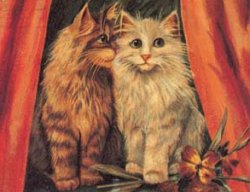 I learn a lesson of life from a little kitten of mine, one of two. The old cat comes in and says, very cross, “I didn’t ask you in here, I like to have my Missus to myself!” And then he runs at them. The bigger and handsomer kitten runs away, but the littler one stands her ground, and when the old enemy comes near enough kisses his nose, and makes peace. That is the lesson of life, to kiss one’s enemy’s nose, always standing one’s ground. --Florence Nightingale, contributed by Benjamin Urrutia
I learn a lesson of life from a little kitten of mine, one of two. The old cat comes in and says, very cross, “I didn’t ask you in here, I like to have my Missus to myself!” And then he runs at them. The bigger and handsomer kitten runs away, but the littler one stands her ground, and when the old enemy comes near enough kisses his nose, and makes peace. That is the lesson of life, to kiss one’s enemy’s nose, always standing one’s ground. --Florence Nightingale, contributed by Benjamin Urrutia
For further information about Florence Nightingale and her cat friends, see Cat Friend
News Notes
Dogs Speak Up in Church
Some thirty dogs attended the Animal Blessing Service for St. Francis Day on Oct. 3 at St. Andrew’s (Anglican) Church, Wirral, in western Britain. They were accompanied by some fifty humans. The speaker reflected on Isaiah’s prophesy of the Peaceable Kingdom and how animals, by their love and loyalty, show us how to be better humans. When he mentioned that his young son had asked if animals go to heaven, one of the Pet Therapy dogs in the congregation barked sharply, inspiring most of the others to join in. Even to the human animals present, unlearned in Dogspeak, the message was clear!
--Contributed by Marian Hussenbux
Heroic Bull Chooses Life
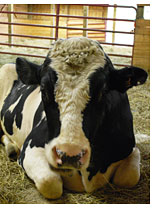 Jay, a 2 year-old bull, managed to survive a flaming traffic crash, major burns, and a 12-hour chase in order to avoid going back to a slaughterhell-bound truck. He is now at Farm Sanctuary and nearing recovery. This story can teach many that farmed animals feel just as we humans do about pain and death. See Jay's Story
Jay, a 2 year-old bull, managed to survive a flaming traffic crash, major burns, and a 12-hour chase in order to avoid going back to a slaughterhell-bound truck. He is now at Farm Sanctuary and nearing recovery. This story can teach many that farmed animals feel just as we humans do about pain and death. See Jay's Story
--Contributed by Lorena Mucke
Bird Brains Aren't Birdbrains
The poultry industry wants people to believe chickens are scarcely more than robots, and many people are happy to swallow the idea. However, scientists such as animal behaviorist Jonathan Balcombe know better. Watch this short movie in which he explains the complex communication system and behavior of chickens. See Bird Brains
--Contributed by Lorena Mucke
A Glimpse of the Peaceable Kingdom
Lion Hug for Rescuer
 Jupiter, a lion rescued years ago from an abusive traveling circus in Colombia by Ana Julia Torres, expresses his grateful love with some claws-up warm physical affection. See Lion Kiss
Jupiter, a lion rescued years ago from an abusive traveling circus in Colombia by Ana Julia Torres, expresses his grateful love with some claws-up warm physical affection. See Lion Kiss
--Contributed by Maria Elena Nava
As in previous issues, we repeat that this kind of expressive love between humans and lions is real, wonderful, and inspiring, but there are too many dangers involved for any but the rare expert/guardian to get this close to a big cat. (And even here, our glimpse of Eden is restricted by bars. . . )
Letter: Steve Willey
Dear Peaceable Friends,
Thanks greatly. I am taking a copy of this [Oct.] and the last issue of PT to our local town vegetarian potluck tonight. There are usually about fifty people attending.
The Sandpoint Vegetarians had a float in the July parade that won first
prize. So most is hopeful here. In a few centuries I believe meat eating
will be entirely rejected. Maybe...
But now I read that on a world basis, flesh eating is increasing
because of developing countries taking up our bad habits, including
factory farming. Discouraging.
Steve Willey
For Friend Steve's remarkable Pioneer narrative, see Willey . http://www.vegetarianfriends.net/issue55.html
Book Review: The Friends We Keep
Laura Hobgood-Oster, The Friends We Keep: Unleashing Christianity's Compassion for Animals. Waco, TX: Baylor University Press, 2010. xx+227 pages. $19.95 paperback.
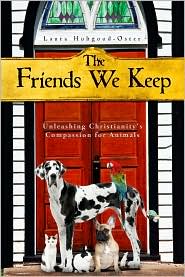 Laura Hobgood-Oster, Professor of Religion and Environmental Studies at Southwestern University in Georgetown, Texas, here presents a convincing case that compassionate concern for animals is indeed a proper part of the Christian faith. She is well aware that some people who consider themselves serious Christians see animals are a minor, perhaps optional, theme in the religion. Up front she cites a blog by Kay Warren, wife of Rick Warren, pastor of the well-known Saddleback megachurch. In "Puppies Are Not People," Kay Warren complained about being "duped, then angered" by television ads showing suffering animals. They do not matter nearly as much as people, Warren opines, climaxing with this grand-slam statement: "Jesus didn't die for animals; he gave his all for human beings."
Laura Hobgood-Oster, Professor of Religion and Environmental Studies at Southwestern University in Georgetown, Texas, here presents a convincing case that compassionate concern for animals is indeed a proper part of the Christian faith. She is well aware that some people who consider themselves serious Christians see animals are a minor, perhaps optional, theme in the religion. Up front she cites a blog by Kay Warren, wife of Rick Warren, pastor of the well-known Saddleback megachurch. In "Puppies Are Not People," Kay Warren complained about being "duped, then angered" by television ads showing suffering animals. They do not matter nearly as much as people, Warren opines, climaxing with this grand-slam statement: "Jesus didn't die for animals; he gave his all for human beings."
Hobgood-Oster begs to differ, and wrote this book to show why. She approaches the topic from several directions, and most of her chapters bring diverse perspectives to bear on such topics as animals in sport, from dog-fights to hunting; animals for food; and animals in contemporary ecological issues, including extinctions. In each of the chapters, drawing on her training as a historian of Christianity, she assesses the theme in biblical, theological, and Christian-legendary literature (including stories of the saints such as those presented in my recent editorial "The Beasts and the Blessed Ones"). While she is certainly aware that most of those tales are scarcely historical, she rightly values them for the way they exemplify in narrative form concerns that must have been on the hearts of many Christians in times past as well as today. Above all, they seem to express the theme of the "Hidden Paradise," as it was put in PT 44: a deep human yearning for a glimpse of a world of beauty and harmony in which human and beast dwell together in love, and none hurt or destroy in all God's holy mountain.
A notable contribution the author makes to the ongoing dialog of animal activism and religion is her placing of the stories of the peaceable interaction of saint and animal in the ancient and medieval tradition of Christian hospitality (a tradition that is still living and active among Friends). In some stories, humans are hosts, and the animals guests; in some cases, vice versa. The context is the basic Christian (and Jewish and Muslim) insight that the earth does not belong to us but to God, and that we are renters, or rather guests, of God.
Moving into the present and her own life, Hobgood-Oster recounts poignant experiences of animals she has known today, mainly companion dogs. The vignettes are often based on her work for the Georgetown Animal Shelter as a volunteer involved in finding new homes for unwanted dogs. If one has lived with such an animal, and looked long and deeply into his or her eyes, it is very hard to believe that creature is only a lesser part of creation, and that her/his suffering matters little in the eyes of the God who made both dog and us.
Finally, the author articulates her own theological view that all that is created by God is sacred to God, and that the Incarnation of God in Christ -- an event more radical than many think -- was not only a taking on of human flesh by the divine, but of all flesh, all life, and so means saving love for all beings. She cites most prominently the great Christian thinker and humanitarian Albert Schweitzer who propounded the "reverence for life" ethic, and who wrote that one is holy if one ". . . does not ask in what way this or that form of life merits or does not merit sympathy as something valuable. . . Life as such is holy." For Hobgood-Oster as for many of us, the final test of the truth of such a proposition would not be theological logic-chopping or scriptural proof-texting, but looking deeply into the eyes of a dog, chimpanzee, or any other such creature under heaven.
The Friends We Keep, written with practical use in mind, concludes with a group discussion guide, lists on "How to Help" for individuals and households as well as for communities and congregations, and finally with a list of "Additional Resources," which I am happy to be able to report includes the website of The Peaceable Table.
This book is an insightful, helpful, and pleasantly written summary of the main animal issues today from both historical and contemporary vantage points. The Friends We Keep is bound to be of great assistance to many as they endeavor to bring those issues to life, and the decision-making point, in families, churches, and communities. We recommend the book and wish it well in this mission.
--Robert Ellwood
Recipes
Creamy Onion Soup
serves 4
3 yellow onions, coarsely chopped
2 large shallots, coarsely chopped
2 T. extra virgin olive oil
2 T. organic unbleached flour
2 cups vegetable broth
¼ tsp. rosemary powder or 1 T. fresh chopped rosemary
sea salt, to taste
freshly ground black pepper, to taste
½ cup soy milk, room temperature
In a heavy saucepan, warm olive oil and add onions and shallots. Cook until translucent, then cover, and continue cooking 5 more minutes. Uncover and quickly blend in flour, using a wooden spoon. Then add broth slowly and stir until thoroughly blended.
Add rosemary, salt and pepper to taste; heat over medium heat until mixture starts to thicken; cook, stirring constantly 1 minute. Reduce to a simmer, cover, and cook 30 minutes. Transfer to a blender container or food processor bowl. Process until smooth. Return to saucepan; add soy milk. Blend well and reheat slowly until hot, stirring often. Do not allow soup to boil. Adjust seasoning as needed. Serve immediately when hot.
-- Angela Suarez
Pumpkin Pie
Crust:
1 ½ cups organic unbleached flour
½ cup Earth Balance Buttery Spread® (1 stick, cut into pieces)
4 - 6 T. ice water
Place flour in the bowl of a food processor (using the dough blade). Add Earth Balance, processing to form a coarse meal. Add water a little at a time with the motor running. Process just enough to form a ball of dough. Roll out dough on a floured board, and transfer to a 9 to 10 inch pie plate.
Pumpkin Filling:
 1 ½ cup organic sugar
1 ½ cup organic sugar
¼ cup organic cornstarch
½ tsp. ground cinnamon
¼ tsp. ground ginger
⅛ tsp. ground cloves
½ tsp. sea salt
1 - 15 oz can organic solid pack pumpkin
¾ cup vanilla flavored soy milk
Preheat oven to 400° F. In a large bowl, stir together sugar, cornstarch, spices and salt. Whisk in pumpkin, then pour into pie crust. Bake for 10 minutes, then reduce oven temperature to 350° F. Bake until pumpkin filling is set, about 35 – 40 minutes. Remove from oven and cool before serving.
This pie is delicious with Soyatoo® vegan whipping cream.
--Angela Suarez
My Pilgrimage: "Awakening"
by Lesa Miller
 I was raised on the typical American meat-and-p0otatoes diet as a child with meat at almost every meal in some form or another. My favorite was grilled steak, charred black on the outside and bloody rare inside! I didn't know any vegetarians then, so I never had reason to question my eating habits.
I was raised on the typical American meat-and-p0otatoes diet as a child with meat at almost every meal in some form or another. My favorite was grilled steak, charred black on the outside and bloody rare inside! I didn't know any vegetarians then, so I never had reason to question my eating habits.
In graduate school, my roommate was vegetarian. I asked her why and she responded by saying she didn't like the way meat felt and tasted in her mouth. I had never expected that answer, but I accepted it. A few years later, and after being married for just over one month, all at once I stopped eating all meat except for seafood. This was the result of an "awakening" I experienced while attending an animal rights conference in Philadelphia, Pennsylvania with a friend.
I had been interested in animal rights, off and on, for a few years, but had never looked into it as deeply as I did that weekend. All it took was seeing the videos, reading the literature, and listening to the speakers to turn me into a blithering idiot. I remember being embarrassed because I cried through the vegetarian and vegan buffet on the last day, and some of the talks, because I was so overwhelmed with information. It seemed the only logical thing I could do was to embrace what I learned and apply it to my own life. I truly had a new philosophy of life, a new way of looking at creatures I had always loved, but now with new knowledge and appreciation. Ever since then, I've been involved in animal rights, whether protesting, leafletting, letter writing, giving membership donations, etc. And I gave up all seafood and dairy products long ago, too.
Nowadays, it's not enough that I'm the student. I want to teach others about the animal issues that are so painful to hear, yet so satisfying to educate others about. I used to feel a sense of urgency about it; but, now that I'm older, I choose to educate others with a more savvy approach.
Humane education is in its infancy, but I foresee schools using it on a regular basis in the future. It's amazing how the same information can be relayed by two different people, in two different ways. This can mean the difference between a highly effective program and a bomb! The facts are a constant, but presentation is (almost) everything to an audience.
It takes persistence and confidence to stand up to those who ridicule and lash out at animal activists. I try to keep in mind that they are people who haven't yet seen and felt the cruelties that I have witnessed. I used to be like them.
From Voices from the Garden, Sharon Towns and Daniel Towns, editors, 2001. Used by permission of the author and editors.
Poetry: Francis Thompson, 1859-1907
from The Hound of Heaven
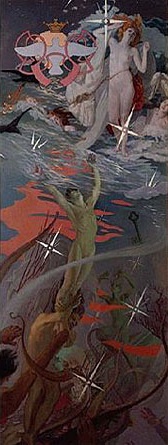 . . . . “Come then, ye other children, Nature’s—share
. . . . “Come then, ye other children, Nature’s—share
With me” (said I) “your delicate fellowship;
Let me greet you lip to lip,
Let me twine with you caresses,
Wantoning
With our Lady-Mother’s vagrant tresses,
Banqueting
With her in her wind-walled palace,
Underneath her azured dais,
Quaffing, as your taintless way is,
From a chalice
Lucent-weeping out of the dayspring.”
So it was done:
I in their delicate fellowship was one—
Drew the bolt of Nature’s secrecies.
I knew all the swift importings
On the wilful face of skies;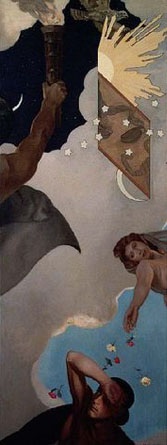
I knew how the clouds arise
Spuméd of the wild sea-snortings;
All that’s born or dies
Rose and drooped with; made them shapers
Of mine own moods, or wailful or divine;
With them joyed and was bereaven.
I was heavy with the even,
When she lit her glimmering tapers
Round the day’s dead sanctities.
I laughed in the morning’s eyes.
I triumphed and I saddened with all weather,
Heaven and I wept together,
And its sweet tears were salt with mortal mine;
Against the red throb of its sunset-heart
I laid my own to beat,
And share commingling heat . . . .
Paintings by R.H. Ives Gammell, from his magnificent book of illustrations entitled The Hound of Heaven: A Pictorial Sequence.
The Peaceable Table is
a project of Quaker Animal Kinship / Animal Kinship Committee of Orange Grove Friends Meeting, Pasadena, California. It is intended to resume the witness of that excellent vehicle of the Friends
Vegetarian Society of North America, The Friendly
Vegetarian, which appeared quarterly between 1982 and
1995. Following its example, and sometimes borrowing from its
treasures, we publish articles for toe-in-the-water
vegetarians as well as long-term ones.
The journal is intended to be
interactive; contributions, including illustrations, are
invited for the next issue. Deadline for the December-January issue
will be Nov 27, 2010. Send to graciafay@gmail.com
or 10 Krotona Hill, Ojai, CA 93023. We operate primarily
online in order to conserve trees and labor, but hard copy
is available for interested persons who are not online.
The latter are asked, if their funds permit, to donate $12 (USD) per year. Other
donations to offset the cost of the domain name and server are welcome.
Website: www.vegetarianfriends.net
Editor: Gracia Fay Ellwood
Book and Film Reviewers: Benjamin Urrutia & Robert Ellwood
Recipe Editor: Angela Suarez
NewsNotes Editors: Lorena Mucke and Marian Hussenbux
Technical Architect: Richard Scott Lancelot Ellwood

-710281.jpg) This is how it worked with Noah. The story tells us that God commanded him to create an ark to protect the animals. But the animals called Noah, too. God’s call was first of all a call to listen to the animals, to hear their callings, and to be ordained by them. But how did God know to do this? Why did God even care? The calling originated out of God’s own listening: a listening to their sufferings and their joys, their playfulness and their wisdom. Listening changes the listener. It is from this listening that God decided to establish a covenant with the animals and to invite Noah to live by this covenant. It is from this listening that we are called even today.
This is how it worked with Noah. The story tells us that God commanded him to create an ark to protect the animals. But the animals called Noah, too. God’s call was first of all a call to listen to the animals, to hear their callings, and to be ordained by them. But how did God know to do this? Why did God even care? The calling originated out of God’s own listening: a listening to their sufferings and their joys, their playfulness and their wisdom. Listening changes the listener. It is from this listening that God decided to establish a covenant with the animals and to invite Noah to live by this covenant. It is from this listening that we are called even today. I learn a lesson of life from a little kitten of mine, one of two. The old cat comes in and says, very cross, “I didn’t ask you in here, I like to have my Missus to myself!” And then he runs at them. The bigger and handsomer kitten runs away, but the littler one stands her ground, and when the old enemy comes near enough kisses his nose, and makes peace. That is the lesson of life, to kiss one’s enemy’s nose, always standing one’s ground. --Florence Nightingale, contributed by Benjamin Urrutia
I learn a lesson of life from a little kitten of mine, one of two. The old cat comes in and says, very cross, “I didn’t ask you in here, I like to have my Missus to myself!” And then he runs at them. The bigger and handsomer kitten runs away, but the littler one stands her ground, and when the old enemy comes near enough kisses his nose, and makes peace. That is the lesson of life, to kiss one’s enemy’s nose, always standing one’s ground. --Florence Nightingale, contributed by Benjamin Urrutia
 Jay, a 2 year-old bull, managed to survive a flaming traffic crash, major burns, and a 12-hour chase in order to avoid going back to a slaughterhell-bound truck. He is now at Farm Sanctuary and nearing recovery. This story can teach many that farmed animals feel just as we humans do about pain and death. See
Jay, a 2 year-old bull, managed to survive a flaming traffic crash, major burns, and a 12-hour chase in order to avoid going back to a slaughterhell-bound truck. He is now at Farm Sanctuary and nearing recovery. This story can teach many that farmed animals feel just as we humans do about pain and death. See  Jupiter, a lion rescued years ago from an abusive traveling circus in Colombia by Ana Julia Torres, expresses his grateful love with some claws-up warm physical affection. See
Jupiter, a lion rescued years ago from an abusive traveling circus in Colombia by Ana Julia Torres, expresses his grateful love with some claws-up warm physical affection. See  Laura Hobgood-Oster, Professor of Religion and Environmental Studies at Southwestern University in Georgetown, Texas, here presents a convincing case that compassionate concern for animals is indeed a proper part of the Christian faith. She is well aware that some people who consider themselves serious Christians see animals are a minor, perhaps optional, theme in the religion. Up front she cites a blog by Kay Warren, wife of Rick Warren, pastor of the well-known Saddleback megachurch. In "Puppies Are Not People," Kay Warren complained about being "duped, then angered" by television ads showing suffering animals. They do not matter nearly as much as people, Warren opines, climaxing with this grand-slam statement: "Jesus didn't die for animals; he gave his all for human beings."
Laura Hobgood-Oster, Professor of Religion and Environmental Studies at Southwestern University in Georgetown, Texas, here presents a convincing case that compassionate concern for animals is indeed a proper part of the Christian faith. She is well aware that some people who consider themselves serious Christians see animals are a minor, perhaps optional, theme in the religion. Up front she cites a blog by Kay Warren, wife of Rick Warren, pastor of the well-known Saddleback megachurch. In "Puppies Are Not People," Kay Warren complained about being "duped, then angered" by television ads showing suffering animals. They do not matter nearly as much as people, Warren opines, climaxing with this grand-slam statement: "Jesus didn't die for animals; he gave his all for human beings." 1 ½ cup organic sugar
1 ½ cup organic sugar I was raised on the typical American meat-and-p0otatoes diet as a child with meat at almost every meal in some form or another. My favorite was grilled steak, charred black on the outside and bloody rare inside! I didn't know any vegetarians then, so I never had reason to question my eating habits.
I was raised on the typical American meat-and-p0otatoes diet as a child with meat at almost every meal in some form or another. My favorite was grilled steak, charred black on the outside and bloody rare inside! I didn't know any vegetarians then, so I never had reason to question my eating habits.  . . . . “Come then, ye other children, Nature’s—share
. . . . “Come then, ye other children, Nature’s—share